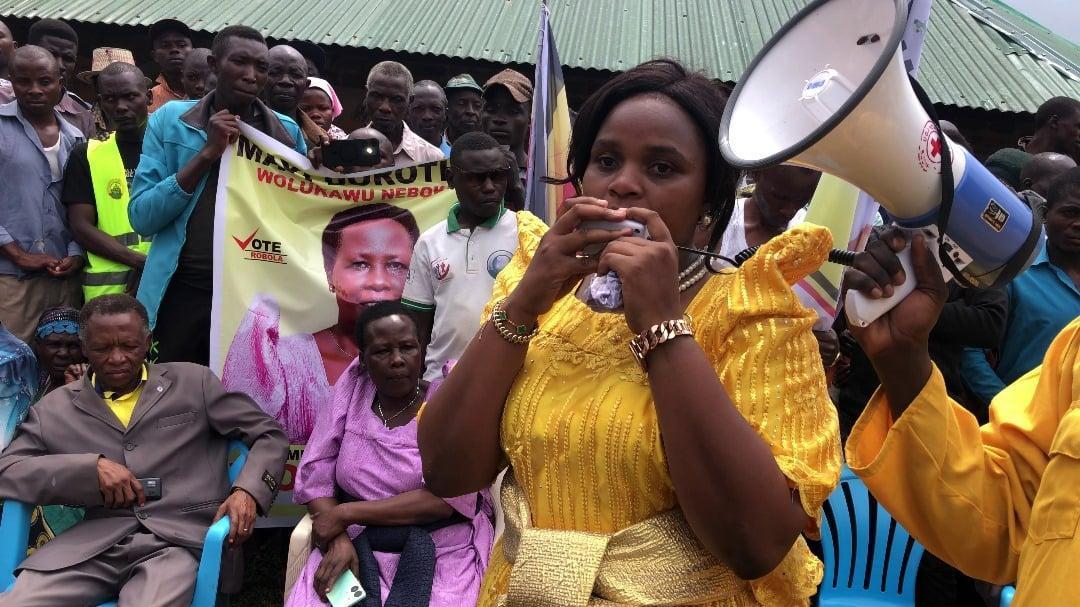Africa-Press – Uganda. Amid scattered chaos and violence in joint National Resistance Movement (NRM) campaign events across Uganda, Namisindwa District has stood out as a beacon of political maturity and discipline.
During recent rallies for woman MP aspirants in Bukokho Sub-county and Bumbo Town Council, supporters of rival candidates mingled peacefully, chanting slogans, waving NRM flags, and applauding each other’s speeches without incident.
The race for Namisindwa District Woman MP has attracted five contenders: Peace Khalayi, Dr Sarah Khanakwa, Canon Grace Namukhula, Dorothy Wolukawu, and Vicot Kharunda.
In a rare display of decorum, all five candidates shared platforms and delivered their messages while both voters and fellow aspirants listened respectfully.
Heckling, walkouts, and sabotage—common features elsewhere—were notably absent.
This civility, according to local party officials, is the result of deliberate structure and clear guidelines issued before every rally.
District NRM leaders open each gathering by outlining rules: no interruptions, no leaving before all candidates speak, and the right for voters to pose direct, issue-based questions.
The result has been a more engaged and discerning electorate. In Bungati Sub-county, Fred Wepukhulu and Yokana Nandelenga publicly challenged former MP Grace Namukhula about the ambulance she had donated during her term but which disappeared after she lost re-election.
Namukhula explained that the vehicle broke down and she could not afford repairs, promising to replace it with two if given a fresh mandate.
In Nabitsikhi, the rally turned sharply toward accountability when residents confronted Bubulo East MP John Musila, popularly known as Raterman, over his failure to upgrade Bubutu Health Centre III as promised during the 2021 campaigns.
“You pledged to work on the facility in your first term. What has changed?” asked Anthony Nakhaika.
Another resident, Meure Geofrey, pushed further, questioning why Musila deserved a second term when key pledges remain unfulfilled.
In response, Musila cited Angororo Dam as a major development achievement—only for locals to point out that the dam was commissioned in 2017, before he became MP.
Dr Sarah Khanakwa, one of the Woman MP aspirants, praised the joint rallies for promoting mutual respect among candidates and voters.
“This format has helped the community understand that political rivals are not enemies. It has encouraged dialogue and high-level interaction,” she said.
Residents echoed similar sentiments, applauding the joint format for simplifying decision-making.
“It reduces confusion. You get to hear all the candidates side by side and make a clearer comparison,” said Pastor Rogers Nandaa from Tsekululu Sub-county.
“I’ve assessed the five candidates and based on their presentations, I believe two are capable of being good representatives.”
Others highlighted the rallies’ tone. “This campaign has portrayed grace, peace, and joy. I like that the candidates are respecting each other,” remarked one elder.
The model has also helped cut campaign costs and encouraged internal party cohesion.
Still, challenges persist. In other districts, especially urban centers, weak oversight has allowed violence to seep in.
In Manafwa, Bungokho North, and Mbale City’s Northern Division, groups of rowdy youths—often ferried in from outside—have disrupted rallies with shouting, heckling, and even violence.
In Namanyonyi, former Masaka RCC Hussein Hudu was nearly attacked after violating rally rules by refusing to share a platform with fellow candidates.
In Butiru County, police fired live bullets to disperse violent clashes between supporters of Wakoli Godfrey and Kefa Mafumo.
Abas Wetaka, a political analyst, blamed the chaos on certain new entrants to politics who import supporters to destabilize their rivals.
“These youths aren’t local—they’ve been brought in to create chaos and drown out incumbents,” he said.
Despite such incidents, many observers believe that the Namisindwa example offers a workable template for political engagement, if the NRM can strengthen enforcement and prevent bad actors from undermining the process.
For now, at least, Namisindwa stands as proof that Uganda’s politics can be both competitive and civil.
For More News And Analysis About Uganda Follow Africa-Press






